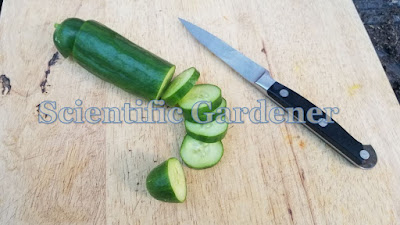Strange and exotic cucumbers have always interested me. The ability of a fruit to do something novel or interesting often spurns the curiosity of most gardeners. For me, this is especially true with cucumbers that can be grown without pollination. The word Parthenocarpy, which is an early 20th century word from the German “Parthenocarpie” which derives its meaning from the green parthenos ‘virgin’ and karpos ‘fruit’. In essence, a parthenocarpic fruit is a virgin fruit, because it is sets without pollination. Parthenocarpy in cucumbers is not a highly common trait in nature.
Both wild cucumbers and most older cucumber varieties are monecious, meaning that they produce both male and female flowers on the same plant. They require a pollinator, such as a bee, to move the pollen from a male flower to a female flower. However, even some monecious cucumber varieties can set female fruit without being pollinated. This ability to set fruit without pollination so intrigued me, that I decided that I needed to do an experiment in which I grew different open-pollinated (non hybrid) cucumber varieties that were touted as parthenocarpic to determine if they lived up to their claims.
In total, I grew out eight regular cucumber varieties (Cucumis sativus) and one cucumber-melon variety (Cucumis melo). Alphabetically, the eight varieties include Beit Alpha, China Jade, Diva, English Telegraph, English Telegraph Improved, Monika, Muncher, Sikkim and The cucumber-melon Meloncella Tonda di Galatina. The Beit Alpha is a somewhat wrinkly, yet smooth thin-skinned cucumber from Israel, while the China Jade is an Asian long-fruited cucumber with spines. Diva is a “Beit Alpha”-type variety with a little larger fruit than the original Beit Alpha. Diva is an All-American selection winner that was released by Johnny’s Select Seeds. English Telegraph and English Telegraph Improved are both long-fruited English hothouse cucumbers. Monika and Muncher are some small smooth-skinned “Beit Alpha”-type cucumbers as well. Sikkim is a very old Indian storage variety, while the Meloncella Tonda di Galatina belongs to the group of cucumber-melons called “carosello” that originate from the Apulian region of Italy.
I decided to grow out my cucumber varieties in the greenhouse in early spring, when very few bees would be around to pollinate. In addition, I kept my greenhouse closed as long as possible after the vines began to flower and had plenty of spiders with spiderwebs to keep flies and bees from visiting the flowers. When the greenhouse became overheated, I only opened the window and door a little to keep too many critters from visiting. I grew the plants out for about 6 weeks.
So, here are my results:
Beit Alpha was parthenocarpic after the first fruit
China Jade primarily produced female flowers. The female fruit held on for a long time even when it was not pollinated. Though most of the female fruit aborted, a couple did not.
Diva had a lot of the female flowers abort. Eventually some flowers did grow.
The English Telegraph and the Telegraph Improved had none of their female flowers set fruit.
The Monika Cucumber was nearly all gynoecious. The vines produced a whole lot of female flowers prior to setting one fruit.
The Muncher cucumber has parthenocarpic tendencies, but never produced an actual fruit. About 4-5 female flowers aborted.
The Sikkim did not produce female flowers until very late. The couple female flowers it did produce did not set fruit.
The Meloncella Tonda di Galatina had a couple female flowers abort. Afterwards, the Galatina produced beautiful fruit with infertile seeds.
So are those varieties that I would classify as having parthenocarpic tendencies:
Beit Alpha: Mostly parthenocarpic
Meloncella Tonda di Galitina
Diva: Only slightly parthenocarpic
China Jade: Very promising. Always trying to set fruit. Only occasionally does. I love the nearly gynoecious tendency of this variety.
Monika: One set fruit. Otherwise extremely productive and nearly, but not fully gynoecious.
So here are some take-aways that I got from the trial:
-Some companies list varieties that are mostly female (gynoecious) as parthenocarpic
-Some companies list Beit Alpha-type varieties as parthenocarpic, just because it has Beit Alpha qualities
-Some parthenocarpic varieties are not truly parthenocarpic, but have genetics that lead them to express these characteristics when environmental conditions favor this expression
-Most all open-pollinated parthenocarpic cucumber varieties will abort one or two fruit before setting parthenocarpic cucumbers.
-Because parthenocarpic traits are likely inherited, then it would impractical for seed growers to select for this trait unless they had a financial incentive to do so. Otherwise, unless the farmer could specifically select for this trait, the parthenocarpic trait of any one variety will wane over time.












































No comments:
Post a Comment
Dear Gardening Friends,
I look forward to learning more about gardening with you. Your comments help me recognize that gardening is a life-long journey.
To advertisers: Note that this blog is concerned with gardening and gardening techniques. Please do not attempt to advertise here by leaving a comment. Depending upon how egregious the comment is, it may be deleted.